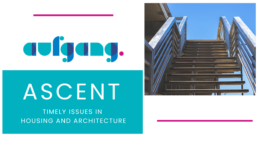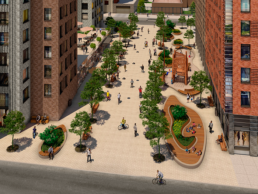
Can pedestrians and bicyclists safely coexist with motor vehicles
on compressed city streets?
Pedestrians and cyclists are threatened by cars, buses and trucks in compressed traffic on city streets. How can urban planners solve this life and death problem? One answer may be found in Europe where the Netherlands has redesigned some city streets to provide a smoother and safer flow of people and motor vehicles. A traffic system, called “woonerf,” which means “shared space” in Dutch, blurs the barrier between street and sidewalk.
“Rather than one standard design, the system has many shared common elements,” says Vivien Ferrari, Senior Designer, Planning and Community Development at Aufgang. “Some have no curbs between areas for people and cars. Others may feature cobblestone or similar rougher road surface materials to encourage drivers to slow down and be more alert and cautious about pedestrians and cyclists.”
This system offers an array of potential benefits:
- Most importantly, slower, smoother traffic flow makes streets safer for close sharing among motor vehicles, pedestrians and cyclists.
- Retail stores may see an increase in business when it’s easier for shoppers to walk around a commercial area.
- More street space can be used to plant trees and other landscaping, beautifying urban areas.
- It can create public gathering spaces that enable social activities and cohesion and strengthen neighborhoods.
- Ideally, dedicated bike lanes lower individual use of cars and reduce traffic congestion.

Can such a pedestrian-centered infrastructure “work” in New York and other large American cities? Some steps can be taken to apply these principles, says Vivien Ferrari. “I would propose adding bike lanes to existing roads along with very clear signage. A series of barriers and distinct road and lane colors will also help to safely separate bike lanes from vehicular traffic. In areas with wide sidewalks, we would incorporate sitting areas and planters where space and property lines allowed.”
There are cultural, scale and infrastructural differences in the U.S. that may reduce the appropriateness and effectiveness of the Dutch system, starting with European drivers’ respect for the need to safely share streets with cyclists.
The COVID-19 pandemic brought a decrease in both vehicular traffic on New York City streets and reduced ridership on the subway and buses as many people worked remotely from home. This has turned around. Traffic is heavier and commuter ridership has substantially grown on public transportation, nearing pre-pandemic levels.
And there are many more pedestrians and cyclists on city streets which unfortunately has brought an expected increase in injuries and fatalities resulting from accidents with cars, trucks and buses. Adapting a European solution to New York and other American cities requires more than changing traffic flows on redesigned urban streetscapes, warns Aufgang’s Vivien Ferrari.
“It will also require a cultural shift based on educating drivers, pedestrians and cyclists,” she says.

